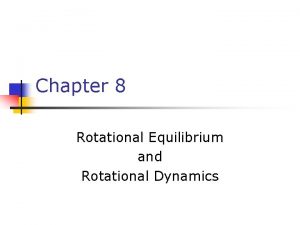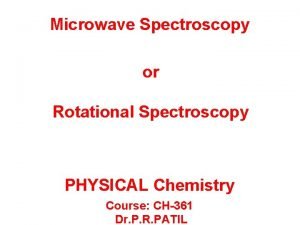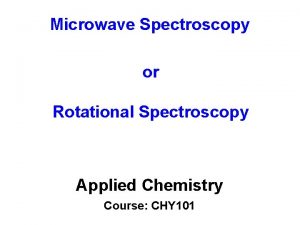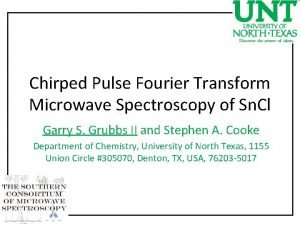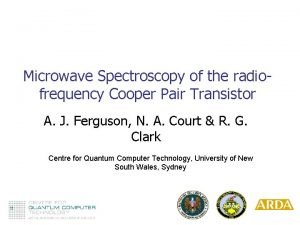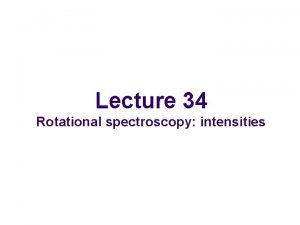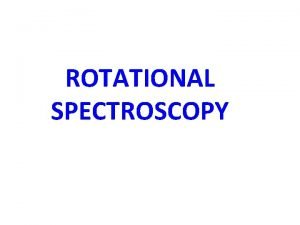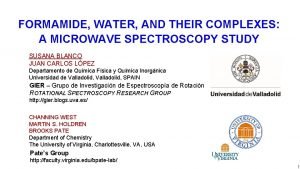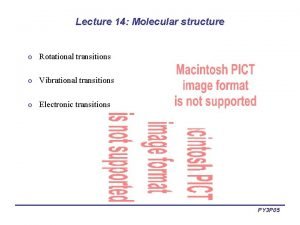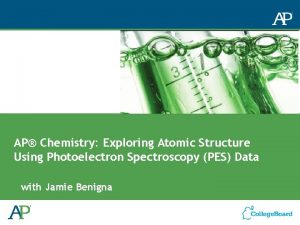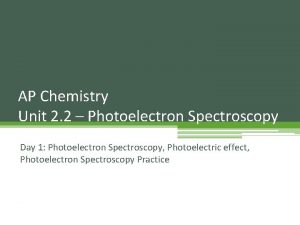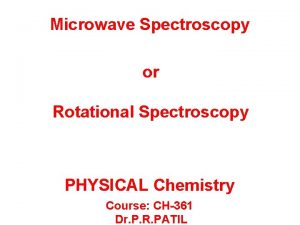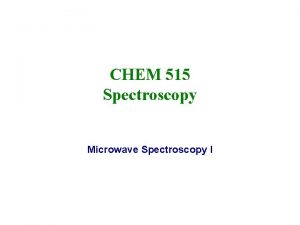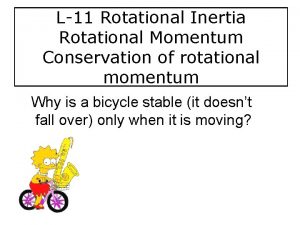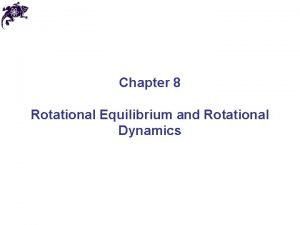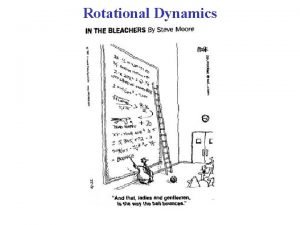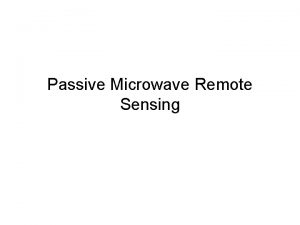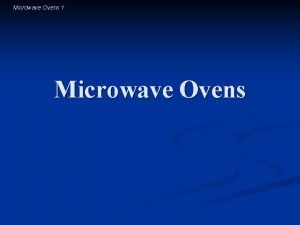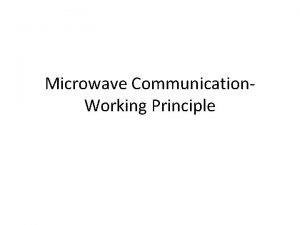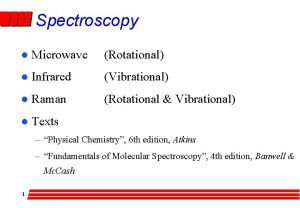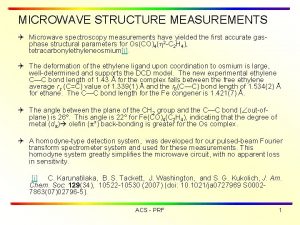Microwave Spectroscopy or Rotational Spectroscopy PHYSICAL Chemistry Course















- Slides: 15

Microwave Spectroscopy or Rotational Spectroscopy PHYSICAL Chemistry Course: CH-361 Dr. P. R. PATIL

Regions of Electromagnetic Radiation Frequency ( ) Wavelength ( ) Radio-waves Region Microwaves Region Infra-red Region Visible Region Ultra-violet Region X-ray Region Frequency (HZ) 106 - 1010 - 1012 - 1014 - 1015 - 1016 - 1018 - 1020 Wavelength 10 m – 1 cm – 100µm – 1µm 700 – 400 nm 400 -10 nm 10 nm – 100 pm – 1 pm NMR, ESR Rotational Spectroscopy Vibrational spectroscopy Electronic Spec. 0. 001 – 10 J/mole Order of some 100 J/mole Some 104 J/mole Some 100 k. J/mole Some 100 s k. J/mole 107 - 109 J/mole 109 - 1011 J/mole Energy UHF TV, cellular, telephones. (300 MHz and 3 GHz) FM Radio, VHF TV. AM Radio Microwave ovens, Police radar, satellite stations-- (3 to 30 GHz) Table lamp, Tube light (400 nm -800 nm or 400– 790 THz) Sun Lamp X-ray

Electromagnetic Radiation

Electromagnetic Wave

Regions of Electromagnetic Radiation

Absorption of Electromagnetic Radiation - The Coupling Mechanism An electromagnetic wave is an oscillating electrical field and interacts only with molecules that can undergo a change in dipole moment. The oscillating dipole can be provided by the rotation of a permanent dipole like for example HCl. This type of interaction leads to microwave spectra H Cl Fig. The rotation of a polar diatomic molecule, showing the fluctuation in the dipole moment measured in a particular direction

Microwave Spectroscopy Incident electromagnetic waves can excite the rotational levels of molecules provided they have an electric dipole moment. The electromagnetic field exerts a torque on the molecule. The spectra for rotational transitions of molecules is typically in the microwave region of the electromagnetic spectrum. v Absorption of microwave radiation causes heating due to increased molecular rotational activity. .

Microwave Spectroscopy Incident electromagnetic waves can excite the rotational levels of molecules provided they have an electric dipole moment. The electromagnetic field exerts a torque on the molecule. v Homonuclear diatomic molecules (such as H 2, O 2, N 2 , Cl 2) – have zero dipole (non polar) -- have zero change of dipole during the rotation – hence NO interaction with radiation -- hence homonuclear diatomic molecules are microwave inactive v Heteronuclear diatomic molecules (such as HCl, HF, CO) – have permanent dipolemoment (polar compound) -- change of dipole occurs during the rotation – hence interaction with radiation takes place – Therefore, heteronuclear diatomic molecules are microwave active.

RIGID ROTOR For simplicity, we can consider only rotational motion of rigid diatomic molecule, A diatomic molecule can rotate around a vertical axis. The rotational energy is quantized. Assume a rigid (not elastic) bond r 0 = r 1 + r 2 For rotation about center of gravity, C : 0 m 1 r 1 = m 2 r 2 = m 2 (r 0 - r 1)

RIGID ROTOR Moment of inertia about C: IC = m 1 r 12 + m 2 r 22 = m 2 r 2 r 1 + m 1 r 1 r 2 = r 1 r 2 (m 1 + m 2) = reduced mass, A diatomic molecule can rotate around a vertical axis. The rotational energy is quantized. By the using Schrödinger equation, the rotational energy levels allowed to the rigid diatomic molecule are given by, J = Rotational quantum number (J = 0, 1, 2, …) I = Moment of inertia = mr 2 = reduced mass = m 1 m 2 / (m 1 + m 2) r = internuclear distance

Energy is quantized Planck suggests that radiation (light, energy) can only come in quantized packets that are of size hν. Planck, 1900 Planck’s constant h = 6. 626 × 10 -34 J·s Energy (J) Frequency (s-1) Note that we can specify the energy by specifying any one of the following: 1. The frequency, n (units: Hz or s-1): 2. The wavelength, λ, (units: m or cm or mm): Recall: 3. The wavenumber, Recall: (units: cm-1 or m-1)

Rotational Spectra of Rigid Diatomic molecule Rotational Energy Levels for rigid rotor: Where

Rotational Spectra of Rigid Diatomic molecule For rigid rotor, J J + 1, The allowed rotational energy levels of a rigid diatomic molecule Allowed transitions between the energy levels of a rigid diatomic molecule and the spectrum

Rotational Spectra of Rigid Rotor Selection Rule: Apart from Specific rule, DJ= 1, Gross rule- the molecule should have a permanent electric dipole moment, m. Thus, homonuclear diatomic molecules do not have a pure rotational spectrum. Heteronuclear diatomic molecules do have rotational spectra.

Rotational Energy levels
 Chapter 11 rotational equilibrium
Chapter 11 rotational equilibrium Second condition of equilibrium
Second condition of equilibrium Rotational spectroscopy notes
Rotational spectroscopy notes Rotational motion
Rotational motion Chirped pulse fourier transform microwave spectroscopy
Chirped pulse fourier transform microwave spectroscopy What is microwave spectroscopy
What is microwave spectroscopy Gross and specific selection rules
Gross and specific selection rules Application of rotational spectroscopy
Application of rotational spectroscopy Rotational spectroscopy notes
Rotational spectroscopy notes Physical chemistry crash course
Physical chemistry crash course Rotational motion chemistry
Rotational motion chemistry Spectroscopy ap chem
Spectroscopy ap chem Magnesium pes spectrum
Magnesium pes spectrum Flemish bond t junction
Flemish bond t junction Course title and course number
Course title and course number Course interne moyenne externe
Course interne moyenne externe
